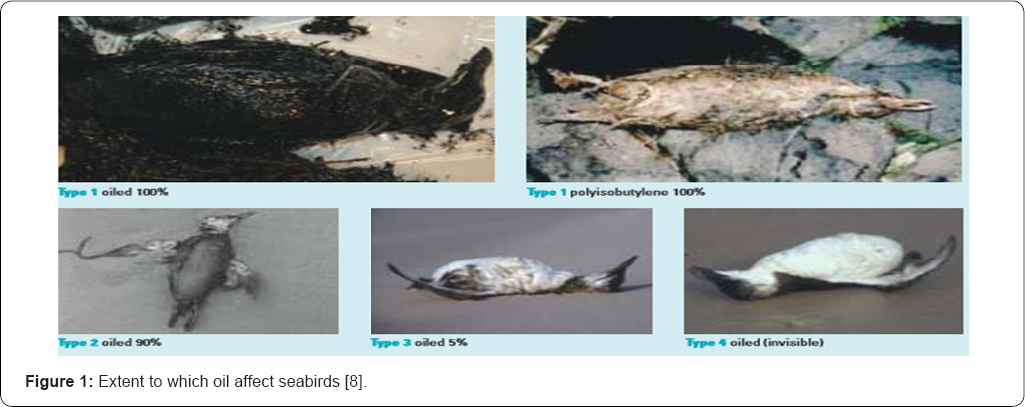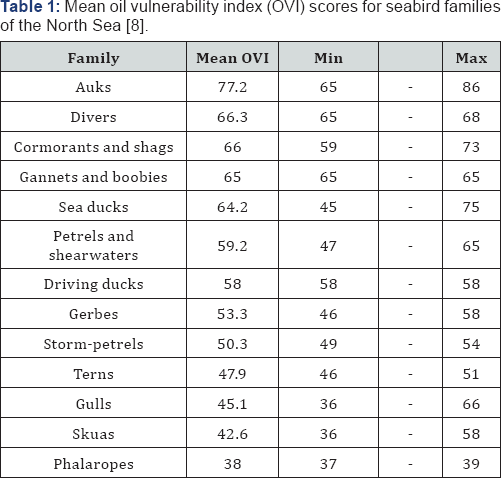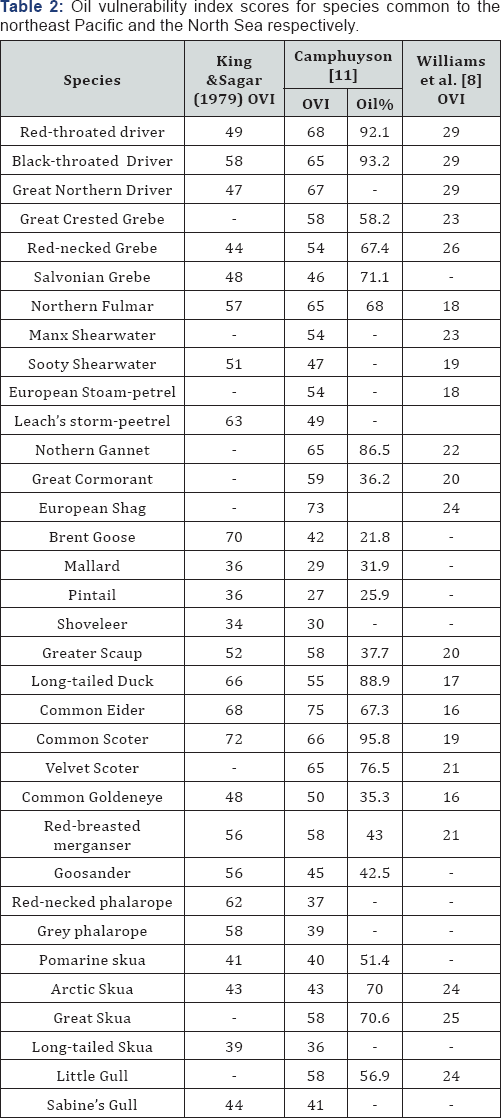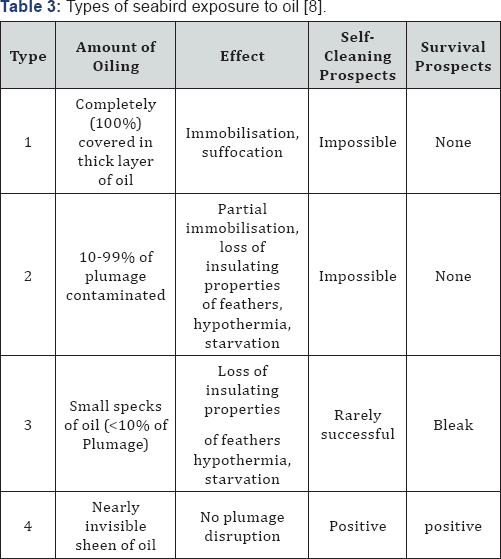The Effects of Chronic Oil Pollution on Seabird Populations
Eluagu RC, Anyadiegwu CIC*, Ohia NP and Obibuike UJ
Department of Petroleum Engineering, Federal University of Technology Owerri, Nigeria
Submission: March 24, 2017 , Published: June 19, 2017
*Corresponding author: Anyadiegwu CIC, Department of Petroleum Engineering, Federal University of Technology Owerri, Nigeria, Email: akhter.engineer@yahoo.com
How to cite this article: Eluagu R, Anyadiegwu C, Ohia N, Obibuike U. The Effects of Chronic Oil Pollution on Seabird Populations. Recent Adv Petrochem Sci. 2017; 2(1): 555576. DOI:10.19080/RAPSCI.2017.02.555576
Abstract
The effects of chronic oil pollution on seabird populations were examined. There is a chronic release of petroleum hydrocarbons from natural and anthropogenic sources into the oceans. Chronic oil pollution is as a result of the continuous stream of smaller and larger oil spills and deliberate / illegal "operational” discharges of oily waste from vessels. This pollution is chronic in that recurring oil discharges in a sensitive area prevent the impacted resources from recovering. It is also noted that chronic oil pollutions are ones of less intense perturbations but their disruption to communities linger for longer periods as opposed to acute disturbances which are of greater intensity and perturbations but lingers for shorter periods. The most lethal form enters the marine environment through deliberate (illegal) discharges into the sea. The most visible effect of marine oil pollution is the associated mortality of marine wildlife, notably seabirds.
Keywords: Chronic; Pollution; Seabird; petroleum; Anthropogenic; Lethal; Marine; Vessel
Abbreviations: OVI: Oil Vulnerability Index; HSS: High Sensitivity Score
Introduction
Oil spills can cause a wide range of impacts in the marine environment and are often portrayed by the media as 'environmental disasters' with dire consequences predicted for the survival of marine flora and fauna. In a major incident, the short term environmental impact can be severe, causing serious distress to ecosystems and to people living near the contaminated coastline affecting their livelihoods and impairing the quality of life. Images of oiled birds following a spill encourage the perception of widespread and permanent environmental damage with the inevitable loss of marine resources. Given the highly charged emotional reactions usually associated with oil spills it can be difficult to obtain a balanced view of the realities of the spill effects and subsequent recovery. A major oil spill can be regarded as an acute disturbance, whereas small natural hydrocarbon seeps or continuous wastewater discharges are chronic disturbances.
The effects of oil pollution are sufficiently well understood to allow for broad indications of the scale and duration of damage for a given incident. A scientific appraisal of typical oil spill effects reveals that while damage occurs and can be profound at the level of individual organisms, populations are more resilient. In time, natural recovery processes can be assisted by removal of the oil the oil through well-conducted clean-up operations and may sometimes be accelerated with carefully managed restoration measures.
Oil pollution sources in the Seawater are mainly due to the following:
a) Daily extraction and transportation of oil in the Sea.
b) Oil tankers accidents.
c) Oils spillage from the oil tankers.
Physical, chemical and biological processes of the oil in the sea will cause many environmental pollution and problems. The oil in the sea will spread very fast on the sea surface. Portion of that will evaporate and some will be dissolved in the water. Oxidation and photochemical reaction will take place at the surface of the water. Sedimentation of the heavy oil by any means to the bottom of the sea is another way of polluting the plants in the sea. Biodegradation of oil by microorganisms may also happen.
Seabird and Oiled Marine Environment
An effect of oil pollution that readily springs to mind is that of seabird mortality. Seabirds are by far the most visible victims of a spill, although it must not be forgotten that they are only one of the groups of organisms affected and only a part of the environmental damage inflicted. It is quite clear that seabirds and oil do not mix. There are a number of reasons why seabirds are exceptionally sensitive to oil pollution, and there are issues that need further attention to make us understand why untreated seabirds die even from a small spot of oil on their feathers. Seabirds depend on the seas and oceans to such a degree that land is an adverse environment for them. Like other birds, however, seabirds need to incubate their eggs on land. For many seabird species, this periodic phase in their breeding cycle is the only time they even approach the coast. The entire juvenile and immature phase and all of the non-breeding period is spent out at sea. Seabirds are fully adapted to life at sea thanks to their perfectly insulating, waterproof plumage and extensive subcutaneous fat layers to keep them warm. Mineral oils (or other fatty floating substances, see above) reduce the insulating properties of feathers by destroying the fine structure that keeps out water droplets [1,2]. Only properly aligned and maintained feathers will ensure that water cannot penetrate to reach the skin, thus keeping the bird buoyant and insulated from the cold. Oil sticks to the feathers, causing them to mat and separate, thus impairing the waterproof properties and exposing the bird's skin to seawater temperatures. This generally leads to hypothermia, especially in cold waters like the North Sea and the North Atlantic. As a behavioural response, birds will instinctively try to get the oil off their feathers by preening. Unfortunately, this often leads to a spreading of the oil over larger parts of the body, and more critically, to ingestion and inhalation of toxic compounds. Several studies have shown that ingestion has long-term effects such as a reduced reproductive success and lower winter survival rates [3,4]. As oiled birds struggle to maintain their body temperature and buoyancy, their feeding is reduced or totally impaired, thus further weakening their body condition and fat reserves. If close to shore, birds may choose to go on land to escape or reduce the effects of hypothermia. Whether on land or at sea, most oiled birds ultimately die due to hypothermia and/or starvation. When considering the effects of a surface pollutant such as oil, it is noteworthy that some seabird species are more aerial than others. Penguins cannot fly at all, auks have short- wings and heavy bodies and swim more than they fly in order to conserve energy, and several species become flightless on a periodic basis as a result of moulting all their flight feathers at once. Albatrosses, petrels, terns and gulls are examples of aerial families that plunge in the water to catch their prey. Some species can roost on land (e.g., gulls and some waterfowl), while others are fully pelagic. A few species (such as frigate birds and cormorants) combine life at sea with a plumage that needs to dry after contact with water. In general terms, the truly pelagic and least aerial species are the most vulnerable to oil pollution. Many of these primarily swimming species feed by diving, and some, like guillemots, forage at spectacular depths [5-7]. Diving deeper than 20 or 30m exerts considerable pressure on plumage, which therefore needs to be in perfect condition to avoid loss of insulation.
Methodology
To understand why certain spills have been more devastating than others in terms of their effect on marine life, it is important to consider that different species and areas vary in terms of their sensitivity to oil. The sensitivity of seabirds depends largely on behavioural characteristics and species- specific differences in terms of the risk of exposure to oil. The sensitivity of sea areas depends mainly on the numbers and Behavior (e.g., feeding, roosting, and passage) of sensitive seabird species occurring there.
Methods for assessing seabird vulnerability to oil pollution
The scale of vulnerability of seabirds depends not only on numbers present but also on behavioural and other characteristics of the species involved. Several studies have examined ways of assessing these characteristics and species-specific sensitivity to oil pollution, as measured by Oil Vulnerability Indices.
The methods considered approaches by three authors to bring about the data use for comparisons. The several methods considered the oil vulnerability index (OVI) of the seabird populations.
The first approach to systematically address this issue for seabirds was that by King & Sanger (1979). They ranked 176 species that depend on marine habitats in the north-eastern Pacific on the basis of 20 factors affecting their survival. Each of these factors was given a score of 0, 1, 3, or 5 respectively representing no relevance, low relevance, medium relevance or high relevance of that factor in increasing sensitivity to oil pollution. The scores for each of the 20 factors were summed to provide an overall oil vulnerability index for each species (maximum score 20 x 5 points=OVI 100). Scores ranged from 88 for some murrelets and auklets down to 19 for the Marsh Hawk, a raptor species. It was noted that scores for several taxa would alter greatly if sub-species were used instead of species, indicating the importance of choice of taxonomic level (Figure 1).

Investigating the method by Camphuysen, applied a similar scoring system to that of King & Sanger (1979) to quantify the oil vulnerability of all regularly occurring species of seabirds in the North Sea. In the approach of Williams et al. [8], he assessed seabird sensitivity to surface pollutants. Rather than rely on expert judgment, He based his scoring procedure on data derived from surveys and scientific studies, which he applied to four factors: a)Behavior (scored using proportion of oiled birds found dead or moribund during beached bird surveys, and the ratio of airborne birds to seaborne birds during surveys out at sea). b. Regional population size (census data). c) Reproductive potential (mean clutch size, maximum clutch size and age at first breeding). d) Reliance on the marine environment (proportion of a population of birds feeding at sea as opposed to on land). Each of these four factors received a score ranging from 1 (low vulnerability) to 5 (very high vulnerability). To obtain an OVI score the factors were then summed as follows:
OVI=2a + 2b + c + d.3.1
Extra weighting was placed on factors a and b as these were considered to be the most important. It was recognized that these scores were area- specific and that the score for each species might change depending on the area considered. Carter et al. [9] and Webb et al. [10] then used the OVIs in combination with data from surveys at sea to map Area Vulnerability Scores (AVS):
AVS=(species in (+ 1) x OVI) 3.2 Where is the density calculated for a species in the area and OVI is the oil vulnerability index for that species?
Results and Discussions
In comparing the various oil vulnerability indices and found significant relationships between OVIs calculated for the same species in different parts of the world. Significant correlations were found between OVIs scored for species represented in both King & Sanger (1979) and [11] (RS=0.572, P=0.001, n=32), between the proportion of oiled beached birds found in the Netherlands and the OVI scores of Camphuysen et al. [11] (RS=0.685, P=0.001, n=21), between the OVIs of Camphuysen and of Williams et al. [8] for the North Sea (RS=0.454, p=0.004, n=37), and between the oil rate of beached birds found in the Netherlands and the OVI scores of Williams et al. (1994) (RS=0.446, p=0.015, n=29). It is found that in Western Europe the seabird families most sensitive to oil pollution are auks, divers, cormorants and shags, gannets and boobies, and sea ducks (Table 1) Mean oil vulnerability index (OVI) scores for seabird families of the North Sea Williams et al. [8].


Moderately sensitive seabirds are petrels and shearwaters, diving ducks, grebes and storm petrels. Species of lower sensitivity are the terns, gulls, skuas, and phalaropes. There are notable exceptions to these family-based generalizations, however, such as the Black-legged Kittiwake, a gull species with a high sensitivity score (OVI 66). Phalaropes rank very low, but this status would change if the analysis took into account vulnerability to oil pollution in their main wintering grounds off the coast of Africa. It is noteworthy that phalaropes ranked significantly higher in analysis, which focuses on an area where phalaropes are common. Moderately sensitive seabirds are petrels and shearwaters, diving ducks, grebes and storm petrels. Species of lower sensitivity are the terns, gulls, skuas, and phalaropes [12-14]. There are notable exceptions to these family-based generalizations, however, such as the Black-legged Kittiwake, a gull species with a high sensitivity score (OVI 66). Phalaropes rank very low, but this status would change if the analysis took into account vulnerability to oil pollution in their main wintering grounds off the coast of Africa [15]. It is noteworthy that phalaropes ranked significantly higher in the analysis, which focuses on an area where phalaropes are common. In essence, all indices score the sensitivity of a species to oil pollution. Some indices divide the determining factors between those that apply to the population as a whole (reproductive success, breeding densities, migratory movements, population size), and those that apply to the behaviour of individual birds (time on the water versus time spent in the air, escape responses to oil pollution, offshore versus onshore distribution, grouping tendencies). Indices allocating scores to each factor have often been based on expert judgment, where scientific data might have been more appropriate if available [16,17]. Despite recent progress, there is still a degree of subjectivity in allocating score values and in weighting the factors against each other. By clearly describing the factors and the considerations involved, and by listing the values of each factor for each species, the quality of the index is open to judgment and to adjustments as and when appropriate. (Table 2) Oil vulnerability index scores for species common to the northeast Pacific and the North Sea respectively [8].
Factors relating to populations as a whole relate primarily to the ability of a population to recover from additional oil-induced mortality. Population size has been used in all vulnerability indices. This could either be the global or regional population, but often the choice has not been made explicit. The usual taxonomic level is species, though perhaps in some cases, sub-species or isolated population size might be more appropriate.
Impacts of the oils on the seabirds
Because of the rapidity of this smothering effect of oil, any surviving casualties found washed ashore will still be in the same physical condition as when they first encountered the oil slick. Human intervention in such cases is limited to quickly cleaning off the oil so as to spare the reserves of birds that are otherwise in good condition. (Table 3) Types of seabird exposure to oil [8].

Types of seabird exposure to oil, short-term effects on performance and condition, and prospects for self-cleaning and survival (in the absence of human intervention). These prospects are described for the more vulnerable and sensitive seabird species that have limited or no possibilities of sustaining themselves when having to leave the water for a stay on land.
Type two casualties are heavily oiled and have disrupted plumage over most of their body, but can still breathe freely and usually are able to swim and stay afloat. Birds in this state will mostly preen, even though wing movements may be hampered by sticky oil. Preening will not have the desired effect however, and these birds will soon die from hypothermia and starvation. Even though fouled by oil, pelagic seabirds will avoid the shore unless they are able to find a quiet location free of predators and human activities. Stranded casualties of this kind usually have depleted fat reserves and are greatly weakened, often suffering also from pneumonia, hypothermia and other physical problems. Human intervention in this case would involve providing immediate attention to both the oil (cleaning) and the birds' physical condition. The third category groups seabirds that have been only slightly oiled. Small amounts of oil coming into contact with birds disrupt their plumage, but otherwise the animal's physical condition is not affected, at least initially. The effect of this slight contact with oil will depend on a number of factors, such as the type of bird, the possibilities to leave the water and stay dry for a while, the time of year (ambient temperatures), the amount and the type of oil, and the possibility to feed. Divers, grebes, sea duck and auks will not normally survive this condition without human intervention. Species that are more airborne, such as gulls and terns, may be better suited to overcome this type of soiling by attempting to clean their feathers while avoiding direct contact with water as much as possible. Oiled seabirds in this category that are unable to deal with the problem and wash ashore as casualties are typically severely emaciated, suffering from depleted fat stores, atrophy of the breast muscles, gut inflammation, internal parasite infections, and pneumonia. By the time birds in this condition are found on beaches, dealing with the oil that started the problem in the first place is far less urgent than attending to the birds' immediate health requirements. The fourth category of contamination is usually overlooked. Birds swimming through oil sheen may not become visibly contaminated, but the hydrocarbons do adhere to the feathers. Very fresh corpses of auks having suffered this kind of oiling typically have a purple or blue shine to their white under-parts, which is barely visible except under perfect light conditions. Only the tips of the feathers may become slightly disrupted and, with exceptions, birds in this condition are normally able to clean themselves and survive [18]. The 'classic' oil incidents are usually remembered because of the Type 1 casualties, which provide sensational media coverage and which are therefore shown as examples of the damage. However, it is important to remember that all four categories of exposure occur, and that relatively less oiled casualties originate from birds entering into contact with an oil spill at its periphery, or in later phases of the incident. The second and third categories of exposure are commonly attributed to chronic oil pollution, rather than large-scale accidents. Beached-bird surveys conducted in the Netherlands since 1970 have shown that of 40,710 intact corpses of oiled Black-legged Kittiwakes Rissatridactyla and large auks (Common Guillemot, Razorbill and Atlantic Puffin Fraterculaarctica), 54% showed signs of only slight contamination (categories 3 and 4). These casualties were unlikely to get much attention or cause public outcry, even although oil was the principal cause of death.
Conclusion
Seabird breeding colonies are a logical place to look for the effects of oil pollution at population level. It is obvious that the effects of oil pollution will be more pronounced the smaller the affected population is in relation to the number of birds killed, but determining the size of the affected population is by no means simple. However, with regard to wildlife casualties, the amount of oil spilled is less important than the season in which spillage occurs, and the location of that spillage. Relatively small spills (including discharges corresponding to chronic oil pollution) may lead to substantial damage and mortality. In this context, the key factors determining the gravity of wildlife casualties by oil are the densities of seabirds present in an affected area at any given time, and the vulnerability of the species present to oil pollution.
From the results it is seen that lethal consequences awaits seabirds as a result of oil pollution in marine ecosystems. There is then a great need to fully study and ascertain the best measures and approach of reducing seabird mortality in affected regions. This will help curb extinction of some species and also aid in marine wildlife conservation.
References
- Holmes WN, Cronshaw J (1977) Biological effects of petroleum on marine birds. In: Malins DC (Ed.) Effects of petroleum on arctic and sub-arctic marine environments and organisms. Biological Effects. Academic Press, New York, USA, pp. 359-398.
- Rozemeijer MJC, Booij K, Swennen C, Boon JP (1992) Molecular features of environmental contaminants causing disruption of the plumage of sea-birds. NIOZ BEWON Report No 43, Nether Inst Sea Res, Texel, pp. 27.
- Leighton FA, Peakall DB, Butler RG (1983) Heinz-body hemolytic anemia from ingestion of crude oil: A primary toxic effect in marine birds. Science 220(4599): 871-873.
- Leighton FA (1993) the toxicity of petroleum oils to birds. Environmental Reviews 1(2): 92-103.
- Piatt JF, Nettleship DN (1985) Diving depths of four alcids. Auk 102: 293-297.
- Lovvorn JR, Jones DJ (1991) Effects of body size, body fat, and changes in pressure with depth on buoyancy and costs of diving in ducks (Aythya spp.). Can J Zool 69(11): 2879-2887.
- Weimerskirch H, Sagar PM (1996) Diving depths of Sooty Shearwaters Puffinusgriseus. Ibis, 138: 786-788.
- Williams JM, Tasker MC, Carter IC, Webb A (1994) A method of assessing seabird vulnerability to surface pollutants. Ibis 137 (Suppl 1): 147-152.
- Carter IC, Williams JM, Webb A, Tasker ML (1993) Seabird concentrations in the North Sea: an atlas of vulnerability to surface pollutants. Joint Nature Conservation Committee, Aberdeen, pp. 39.
- Webb A, Stronach A, Tasker ML, Stone CJ (1995) Vulnerable concentrations of seabirds south and west of Britain. Joint Nature Conservation Committee, Peterborough, pp. 47.
- Camphuysen CJ (1989) Beached-bird Surveys in the Netherlands 1915-1988; Seabird Mortality in the southern North Sea since the early days of Oil Pollution. Techn Rapport Vogelbescherming 1, WerkgroepNoordzee, Amsterdam, Netherlands, p. 322.
- Camphuysen CJ (1990a) Verstrikking van zeevogels in plastics: eenprobleem van toenemendeomvang? Sula 4(1): 12-18.
- Camphuysen CJ (1993) Summer distribution of seabirds and marine mammals in the Greenland Sea, 1985-90. Sula (7): 45-64.
- Bakken HGLV, Mehlum F (1996) Marine birds in the marginal ice zone of the Barents Sea in late winter and spring. Arctic 49(1): 53-61.
- Williams JM, Webb A, Tasker ML (1993) Seabird concentrations in the North Sea: an atlas of vulnerability to surface pollutants. Joint Nature Conservation Committee, Aberdeen, pp.39.
- Piatt J, Roseneau D (1999) Can murres recover from effects of the Exxon Valdez oil spill? Sisyphus news (1):1-5.
- Piatt JF, Gould PJ (1994) Post-breeding dispersal and drift-net mortality of endangered Japanese Murrelets. the Auk 111(4): 953-961.
- Tasker WML (1993) Seabird concentrations in the North Sea: an atlas of vulnerability to surface pollutants. Joint Nature Conservation Committee, Aberdeen, pp. 39.






























